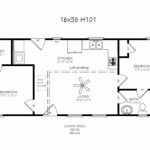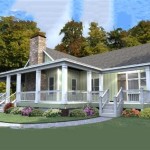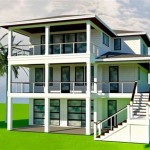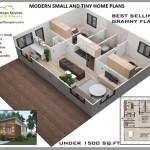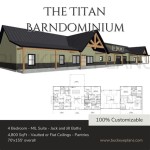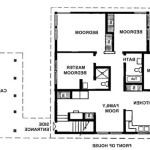House Plans With Sunroom On Front: Embracing Natural Light and Enhanced Living
The integration of a sunroom into residential architecture has long been sought after due to its ability to seamlessly blend indoor comfort with the beauty of the outdoors. When positioned at the front of a house, a sunroom offers a particularly appealing aesthetic and functional advantage. These house plans, often referred to as "house plans with sunroom on front," present a unique opportunity to maximize natural light, create a welcoming entrance, and expand living space in a manner that enhances both the curb appeal and the internal ambiance of the home.
The strategic placement of a sunroom on the front of a house requires careful consideration during the design phase. Architects and homeowners must account for factors such as solar orientation, prevailing wind patterns, and the overall architectural style of the residence. A well-designed front sunroom will not only complement the existing structure but also optimize energy efficiency and provide a comfortable living environment throughout the year.
The purpose of this exposition extends beyond a mere description of these architectural designs. It aims to elucidate the various benefits, design considerations, and architectural styles that contribute to the successful integration of a sunroom into the front facade of a house. Furthermore, it will explore practical considerations such as material selection, construction techniques, and regulatory requirements that are crucial for the successful implementation of these house plans.
Maximizing Natural Light and Energy Efficiency
One of the primary advantages of designing a house with a sunroom on the front is the ability to maximize natural light penetration into the interior spaces. A strategically positioned sunroom can capture sunlight throughout the day, reducing the need for artificial lighting and contributing to a brighter and more cheerful living environment. This is particularly beneficial in regions with long winters or climates that experience extended periods of overcast skies.
The design of the sunroom itself plays a crucial role in optimizing natural light. Large windows and glass doors should be incorporated to allow ample sunlight to enter. The use of low-emissivity (low-E) glass can further enhance energy efficiency by reducing heat transfer, keeping the sunroom cooler in the summer and warmer in the winter. The orientation of the sunroom relative to the sun's path is also a critical factor. In cooler climates, a south-facing sunroom will typically receive the most sunlight throughout the year, while in warmer climates, an east- or west-facing sunroom may be preferable to avoid excessive heat gain.
Beyond natural light, a well-designed front sunroom can also contribute to overall energy efficiency by acting as a passive solar heating system. During the winter months, the sun's rays can penetrate the glass and warm the sunroom, which in turn can help to heat the adjacent rooms in the house. This can significantly reduce heating costs and create a more comfortable living environment. Conversely, during the summer months, shading devices such as awnings, blinds, or strategically planted trees can help to block the sun's rays and prevent overheating. Proper ventilation is also essential for maintaining a comfortable temperature and preventing moisture buildup.
Furthermore, the materials used in the construction of the sunroom can also impact energy efficiency. Insulated walls, roofs, and floors can help to minimize heat loss in the winter and heat gain in the summer. The choice of flooring materials can also affect the temperature of the sunroom. For example, tile or stone flooring can absorb heat during the day and release it slowly at night, helping to regulate the temperature. Careful consideration of these factors during the design and construction phases is essential for maximizing the energy efficiency and comfort of a front sunroom.
Enhancing Curb Appeal and Creating a Welcoming Entrance
In addition to its functional benefits, a sunroom on the front of a house can significantly enhance curb appeal and create a welcoming entrance. The addition of a sunroom can add visual interest to the facade of the house, making it more aesthetically pleasing and inviting. This is particularly true for houses with a simple or traditional architectural style. A well-designed sunroom can add a touch of elegance and sophistication, transforming the overall look of the house.
The architectural style of the sunroom should complement the existing style of the house. For example, a Victorian-style house might benefit from a sunroom with ornate detailing and curved windows, while a contemporary-style house might be better suited to a sunroom with clean lines and minimalist design. The materials used in the construction of the sunroom should also be consistent with the materials used in the rest of the house. For example, if the house is brick, the sunroom should also incorporate brick elements to create a cohesive look.
The placement of the sunroom relative to the front entrance is also an important consideration. A sunroom that is located directly in front of the entrance can create a welcoming and inviting atmosphere. The sunroom can serve as a transition space between the outdoors and the indoors, providing a place to relax and enjoy the view. It can also be used as a mudroom or entryway, providing a place to store coats, shoes, and other items. Alternatively, a sunroom that is located to the side of the entrance can provide a more private and secluded space. In this case, the sunroom might be used as a reading room, a home office, or a small sitting area.
Landscaping can also play a role in enhancing the curb appeal of a house with a sunroom on the front. Planting trees, shrubs, and flowers around the sunroom can create a more natural and inviting environment. The landscaping should be carefully planned to complement the architectural style of the house and the sunroom. For example, a Victorian-style house might benefit from a formal garden with manicured lawns and flower beds, while a contemporary-style house might be better suited to a more minimalist landscape with native plants and natural stone features.
Expanding Living Space and Creating Versatile Rooms
A sunroom on the front of a house can also serve as a valuable extension of the living space, providing a versatile area that can be used for a variety of purposes. The additional space can be particularly beneficial for families that need more room for entertaining, relaxing, or pursuing hobbies. A sunroom can be used as a living room, dining room, home office, playroom, or even a guest bedroom. The possibilities are endless.
The design of the sunroom should reflect its intended use. For example, if the sunroom is to be used as a living room, it should be furnished with comfortable seating, tables, and lighting. If it is to be used as a dining room, it should have a dining table and chairs. If it is to be used as a home office, it should have a desk, chair, and storage cabinets. The sunroom should also be decorated in a way that is consistent with its intended use. For example, a sunroom that is used as a living room might be decorated with plants, artwork, and throw pillows, while a sunroom that is used as a home office might be decorated with books, files, and computer equipment.
The size of the sunroom will also depend on its intended use and the overall size of the house. A small sunroom may be sufficient for a single person or a couple, while a larger sunroom may be necessary for a family with children. The shape of the sunroom can also be varied to suit the needs of the homeowner. A rectangular sunroom is the most common shape, but other shapes such as square, octagonal, or even curved sunrooms can be created. The choice of shape will depend on the architectural style of the house and the desired aesthetic.
Consideration should be given to the connection between the sunroom and the rest of the house. Ideally, the sunroom should be easily accessible from the main living areas of the house. This can be achieved by creating a large opening between the sunroom and the adjacent room, or by installing a set of French doors or sliding glass doors. The flooring materials in the sunroom should also be consistent with the flooring materials in the rest of the house to create a seamless transition. The integration of a front sunroom into the home's existing layout is paramount for achieving a harmonious and functional living space.
In conclusion, incorporating a sunroom into the front of a house presents a myriad of benefits, ranging from enhanced natural light and energy efficiency to improved curb appeal and expanded living space. However, the successful integration of a front sunroom requires careful planning, design, and construction. By considering the factors discussed above, homeowners and architects can create a beautiful and functional sunroom that enhances the quality of life and adds value to the property.

House Plans With Sunrooms Or 4 Season Rooms

House Plans With Sunrooms Or 4 Season Rooms

House Plans With Solarium Or Sun Room Drummond

Craftsman House With 4 Bedrooms Outdoor Living And A Nook Plan 4746

House Plans With Solarium Or Sun Room Drummond

Sitting And Sun Rooms 35030gh Architectural Designs House Plans

3 Bedroom Country Home Plan With Sunroom

House Plans With Sunrooms Or 4 Season Rooms

Beautiful 3 Bed Colonial Farmhouse Plan With Sunroom 23779jd Architectural Designs House Plans

House Plans With Solarium Or Sun Room Drummond
Related Posts



